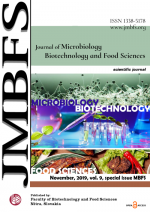ISOLATION OF MONOCYTES FROM BOVINE BLOOD FOR PURPOSES OF CULTURE OF DENDRITIC CELLS
DOI:
https://doi.org/10.15414/jmbfs.2019.9.special.427-430Keywords:
dendritic cell, monocyte, leukocyte, CD14, light microscopyAbstract
Monocytes comprise a population of mononuclear leukocytes. In this article, we compare methods for isolating monocytes and also their cultivation into dendritic cells. Bovine blood collected from the vena jugularis externa was used for the experiment. This blood was used for isolating monocytes based on density gradient of OptiPrep or Histopaque solutions. The results indicated that the more efficient method is isolation based on density gradient of the Histopaque solution and subsequent magnetic separation of the cells. The monocyte population was further cultivated for 72 h with IL-4 and GM-CSF. The cells were evaluated under a light microscope, and it was apparent that CD14-positive cells transformed to dendritic cells. The second method using the Histopaque solution and magnetic separation was more efficient for the subsequent culture of dendritic cells.Downloads
Download data is not yet available.
Downloads
Published
2019-11-08
How to Cite
Kratochvilova, L., Coufalova, K., Zouharova, M., Szczotka, M., & Slama, P. (2019). ISOLATION OF MONOCYTES FROM BOVINE BLOOD FOR PURPOSES OF CULTURE OF DENDRITIC CELLS. Journal of Microbiology, Biotechnology and Food Sciences, 9(Special issue), 427–430. https://doi.org/10.15414/jmbfs.2019.9.special.427-430
Issue
Section
Biotechnology
License
Copyright (c) 2022 Lucie Kratochvilova, Karmela Coufalova, Monika Zouharova, Maria Szczotka, Petr Slama

This work is licensed under a Creative Commons Attribution 4.0 International License.
All papers published in the Journal of Microbiology, Biotechnology and Food Sciences are published under a CC-BY licence (CC-BY 4.0). Published materials can be shared (copy and redistribute the material in any medium or format) and adapted (remix, transform, and build upon the material for any purpose, even commercially) with specifying the author(s).





